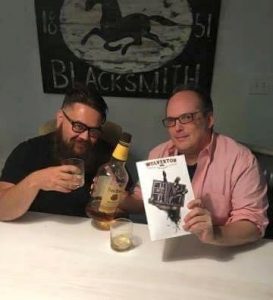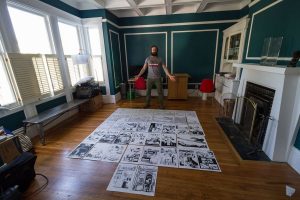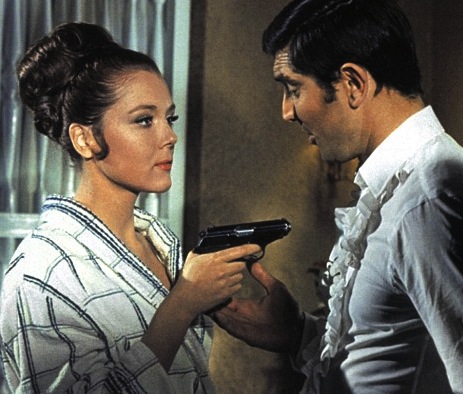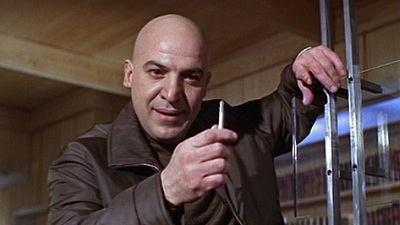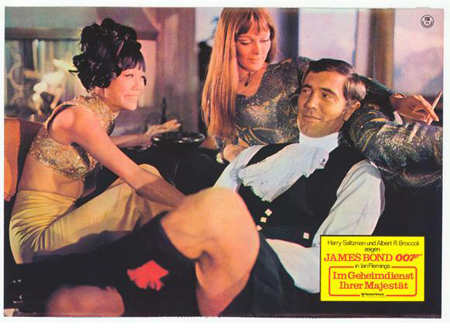by Melanie Crew
Managing Editor
Michael Stark, former screenwriter for Disney and Universal Pictures and current purveyor of rare horror and sci-fi books (Burnt Biscuit Books) “in the shadows of Pinewood Studios,” and Terrell T. Garrett, screenwriter, reside south of the Atlanta Airport, a.k.a. “Hillbilly Hollywood.” Having written several screenplays together, they decided to take an artistic leap and are currently in the process of producing their first comic, “WOLVERTON: THIEF OF IMPOSSIBLE OBJECTS, along with artist Derek Rodenbeck. Initially slated for the big screen but not quite making it past Hollywood’s current aversion to original works, WOLVERTON was revived as a self-published comic book and labor of love for Stark and Garrett. This action-packed story entangles Jack Wolverton, gentleman thief, within a wicked supernatural web, and “Only he can save the world’s most powerful artifacts from getting into the wrong hands.” While their tale takes place in turn of the century London and Wolverton holds H.G. Wells’ science in high esteem, as opposed to the superstition-riddled occultish general population, “Wolverton isn’t exactly steampunk,” tweeted Stark. “He’s more Schvitz Punk!” The premier issue is finished, however, Stark and Garrett made a decision to add four previously cut pages back in before it goes to the printers, so all you retro-fabulous turn of the century comic-loving kiddies will have more action-packed goodness when it hits the shelves!
Stark and Garrett’s home-grown labor of love is being crowd-funded by a Kickstarter campaign, in part to cover printing costs (28 full-color pages with a 5000 copy run!), but also to put feelers out to gauge interest in their project. They are offering many enticing perks for backers, including digital and hard copies, exclusive signed prints and the chance for a few lucky folks to get drawn and/or written into the action. So come on out and be a part of WOLVERTON history and snatch up an adventurous perk or two via the Kickstarter campaign available through July 6! Check out the full range of rewards here!
ATLRetro caught up with Michael Stark and Terrell T. Garrett to gab a bit about their upcoming comic, writing for the Hollywood machine; and why going with crowd-funding made sense for this project. While you’re takin’ a gander at our little Q&A, why not take a peek at the teaser trailer and a wee history of WOLVERTON here.
ATLRetro: How did you and your co-writer, Terrell T. Garrett, come up with the idea of “Wolverton?” What inspired the tale and why set the story in turn of the century London?
Michael: I had an old script about a gentleman thief that I pitched to Sean Connery’s company before he did ENTRAPMENT. I wanted to dust it off, but Terrell yawned, finding the trope a bit old-fashioned. So, out of the blue I blurted out: “What if we set it in Edwardian England and he only stole magical objects like the Monkey’s paw?” Suddenly, my writing partner leaned in, very interested, and we knew we had a great idea.
Can you tell our readers a little about the creative team behind WOLVERTON?
Michael: I was making a good living writing in Hollywood in the ’90s without actually having anything produced. Those days have changed. The new normal is free options and free rewrites which is why I started looking at trying a different format. Our artist, Derek Rodenbeck, was an army vet whose testimony of overcoming great tragedy with his art really moved us. We think we found a very talented, young man.
Terrell: I’m currently adapting Alistair MacLean‘s novel, FEAR IS THE KEY, for the big screen. In fact, most of the stuff I’ve written has been in the screenplay format except for a few short stories here and there and a novel that I’m working on at a glacial pace. I’m also a new father.
What is it about the “gentleman thief” trope that inspires you to create a character like Jack Wolverton?
Michael: We were getting known in Hollywood for writing wild set pieces. I wanted to do something that mixed action with the wit and sophistication of a Preston Sturges or an Ernst Lubitch film. The Gentleman Thief trope fit both worlds perfectly.
We see that you and Garrett worked together on several screenplays, and that you’ve optioned a few to Universal and Disney. Comics and film are similar in that they both rely on dialogue, action and visuals to deliver an awe-inspiring story. As a screenwriter and now a comic book writer, what would you say are the biggest differences between the two, and the challenges of each?
Michael: I thought it would be pretty easy to transpose the script into comic book format. I was dead wrong! Especially because modern comic books like modern screenplays have far less text in ‘em than when I was a kid. So, even after we basically locked the book, I’m still calling the letterer and asking if we can fit in a new bit.
Can you tell our readers what drew you to screenwriting, and who would you say are your most inspirational screenwriters/films?
Michael: Thank God for PBS in the 70s. I saw a Francois Truffaut and Luis Bunuel film festival when I was 10 years old and knew then I wanted to be a screenwriter. Not a director ’cause I looked lousy in jodhpurs. At NYU, I mentored under three Academy winning screenwriters: Ring Lardner JR (MASH, WOMAN OF THE YEAR), Waldo Salt (MIDNIGHT COWBOY, SERPICO) and Ian Hunter, who could tear apart and fix just about anything.
Terrell: I knew I wanted to be a filmmaker when I saw JURASSIC PARK when I was 14 years old. Something about the collective awe in the theater and seeing all the names in the credits made me realize I wanted to be a part of the movie magic. My favorite screenwriters and filmmakers who inspire me are Walter Hill (ALIEN franchise), James Cameron, Jane Goldman (KICK-ASS), Frank Darabont (THE MIST), Dan Gilroy (NIGHTCRAWLER), Joe Carnahan (THE GREY), Bryan Fuller (HANNIBAL TV series), Jon Spaihts (DOCTOR STRANGE, PROMETHEUS) and Diablo Cody (JUNO).
Of course we have to know, as a native Long Islander, what made you fly south, and what is it about Atlanta that’s kept you around for so long?
Michael: That is a very long and surreal story, but basically I was given a month to live a decade ago and went on a spiritual journey that ended up with this nice, Jewish kid from Long Island becoming a minister in a small, rural GA church. That of course would make a good screenplay, but I strictly believe in never writing about your own life. Oh, yeah, I didn’t die BTW.
 Most kids (and now adults, as the guilty pleasure no longer carries the negative geek stigma) can’t wait to get their grubby little hands on the coolest of the cool comics. What comics were your favorite growing up and what are your favorites now?
Most kids (and now adults, as the guilty pleasure no longer carries the negative geek stigma) can’t wait to get their grubby little hands on the coolest of the cool comics. What comics were your favorite growing up and what are your favorites now?
Terrell: I grew up reading Chris Claremont X-MEN comics and the ’90s issues of THE NEW MUTANTS. PREACHER and Neil Gaiman‘s SANDMAN blew my teenage mind. These days, I’m enjoying Alan Moore‘s PROVIDENCE, Brian K. Vaughan‘s SAGA and Matt Fraction‘s ODY-C.
Michael: Team Marvel and mind warping EC reprints. Now anything by Alan Moore.
WOLVERTON began as an original screenplay and was then regenerated into a comic book. Can you tell us a little about that process and whether seeing it drawn on the page in color helps visualize how it will look on the big screen?
Michael: The screenplay was a director’s wet dream with action scenes that were beyond hyper kinetic. Derek did a great job capturing that energy on the page. Even Wolverton’s hair is constantly in motion.
Any plans to take the tale back to Hollywood after its success as a comic book?
Michael: Well, there was just a huge bidding war over a friend’s graphic novel, so, yes! Hollywood is more interested in acquiring existing material than original screenplays. Maybe they’ll come to us this time if the comic book is successful.
Why a Kickstarter campaign for WOLVERTON? What are the advantages of taking the crowd-sourcing route?
Terrell: We chose Kickstarter because it just felt logical. A lot of creatives have used the crowd-sourcing platform  and have found success, especially in the realm of comics. We figured it was worth a shot. Not only to hopefully cover the cost of printing, but to see if people would be interested in our little story.
and have found success, especially in the realm of comics. We figured it was worth a shot. Not only to hopefully cover the cost of printing, but to see if people would be interested in our little story.
You’ve put together some great bonuses for investors, ranging from digital and hard copies to exclusive signed prints and the chance to get drawn into the action (Exciting!). What can folks looking to invest via Kickstarter expect to get when they back your comic?
Terrell: Backers can, firstly, expect a fun adventure story full of cool visuals, sparking dialogue and great characters. Secondly, for the backers who dish out a little extra, they can expect to see their likeness or the name of their business in comic book form or own exciting and original artwork. Thirdly, they can know that they invested in a story with little risk, and have contributed to the dream of a brand new father.
Can you give us five things you’re into at the moment that we should be watching, reading or listening to right now— past or present, well-known or obscure?
Terrell: Nonfiction Book: MIND HUNTER: INSIDE THE FBI’S ELITE SERIAL CRIME UNIT by John E. Douglas. Podcast: LIMETOWN. Podcast: THE BLACK TAPES. Science Fiction Book: RED RISING by Pierce Brown. Novella: “Agents of Dreamland” by Caitlin R. Kiernan.
Michael: I’m cycling through John Ford westerns and Jeeves and Wooster books at the moment. I’m not sure what I’ll spit out after that combo meal. Although, Terrell and I already wrote a script about Buffalo Bill’s Wild West Show in Victorian London. That may be our next comic book.
Any advice for writers and/or artists out there on putting together and publishing their own comic books?
Terrell: Treat the artist as your collaborator. Be patient with the process. Never give up.
Michael: Who knew sticking it to the man – the man being Hollywood – would be so damn expensive. Many people I went to film school with are now editors at Marvel and DC. Some even started their own publishing companies. I knew if I asked for their advice, they’d probably talk me out of it and I didn’t want to be talked out of it.
Getting back to why we’re here chatting you up, WOLVERTON, and the comic book’s Kickstarter campaign! Without giving too much away, what can you tell our readers a little about the comic?
 Michael: Here’s how we pitched it to Hollywood. In turn of the century London, Jack Wolverton, gentleman thief, specializes in stealing the arcane, the accursed and the occult. With war about to break out, only he can stop the world’s most powerful artifacts (The Monkey’s Paw, The Hope Diamond and the Portrait of Dorian Gray) from falling into the wrong hands! Think Indiana Jones meets Pirates of the Caribbean.
Michael: Here’s how we pitched it to Hollywood. In turn of the century London, Jack Wolverton, gentleman thief, specializes in stealing the arcane, the accursed and the occult. With war about to break out, only he can stop the world’s most powerful artifacts (The Monkey’s Paw, The Hope Diamond and the Portrait of Dorian Gray) from falling into the wrong hands! Think Indiana Jones meets Pirates of the Caribbean.
And last but not least, how many issues are planned and how can our readers snag up their very own copies?
Michael: We are printing up 5,000 copies and you can get a copy before anyone on the planet does by backing us now. If the ship carrying them through the high China Seas isn’t attacked by pirates, expect a summer release.
All photos courtesy of Michael Stark and Terrell T. Garrett and used with permission.

